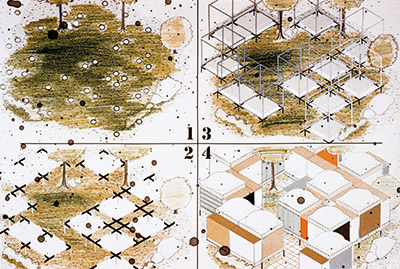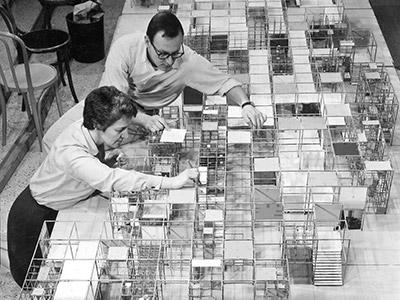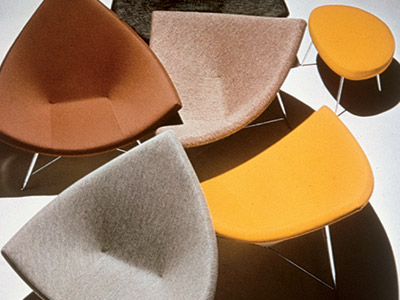Exhibits
 |
Experimental House
The model is based on the no longer extant original model created in the Nelson office with the assistance of Nelson employees Ronald Beckman and William Katavolos. One of Nelson‘s chief interests in the area of architecture was the industrialization of building. From the early 1940s through the early 1960s, he was intensely concerned with the possibilities of serially prefabricating the component parts of the home. His deliberations on the topic crystallized in the Experimental House, which he originally conceived for a model housing project of innovative homes in Grand Rapids, Michigan. The Experimental House was based on two types of cube-shaped modules, which themselves consisted of wall panels inserted into an aluminum frame. With the dimensions 12’’ x 12’’ x 12’’ and a transparent dome roof, the larger cubes were to contain the actual living areas: living room, bedroom, bathroom, kitchen, and study. The smaller modules measuring 12’’ x 4’’ with a flat roof could be attached to the larger units. The modular construction method was intended to enable home buyers to expand or reduce the size of their house over |
 |
Model of the Jungle Gym for the American National Exhibition in Moscow
With the Jungle Gym, the Nelson office developed a gigantic framework for an extensive exhibition of American products in the Welton Becket Pavilion. The framework could be accessed on two floors, adequately and flexibly offering space for furniture, toys, sports equipment, electrical appliances, a fully automated open-view kitchen, and a completely furnished open-view apartment, inhabited during the exhibition by Americans commissioned to act as if they lived there. The Nelson office built three different models of the Jungle Gym in various sizes and in various materials: natural wood, wood painted black, and metal. Unfortunately there are no surviving examples. The reconstruction is derived from the largest of the three models, though it employs wood unlike the original model that was presumably made of brass. It still illustrates the modular character of the three-dimensional framework, which was based on cubes measuring 3 x 3 x 3 meters. |
 |
CLOCKS
The collaboration between George Nelson and the Howard Miller Clock Company began in 1947 and lasted more than 35 years. During this period, Nelson and his office developed over 130 clocks models for Howard Miller. The design of the clock series was based on Nelson’s insight that people told the time by viewing the position of a clock’s hands, not by looking at the numbers. His second observation was that wall clocks in the age of the wristwatch were no longer first and foremost about indicating the time but served as “decorative elements in the furnishings of a room”. The clock series thus formed a counterpoint to the simplicity that Nelson promoted with his storage furniture designs. Furthermore, the early clocks all featured the same internal clock mechanism despite the variety of their outward appearance, which helped to keep production cost low. |
 |
Marshmallow Sofa
This armchair was initially produced with a seat of bent steel that was cushioned with foam and covered with fabric or Naugahyde. Later, Herman Miller produced the seat using fiberglass-reinforced polyester. The frame was at first strengthened using bent steel rods that echoed the form of the chair. Later, the three legs of the chair were screwed individually into the seat. |
 |
Coconut Chair with Ottoman
This armchair was initially produced with a seat of bent steel that was cushioned with foam and covered with fabric or Naugahyde. Later, Herman Miller produced the seat using fiberglass-reinforced polyester. The frame was at first strengthened using bent steel rods that echoed the form of the chair. Later, the three legs of the chair were screwed |